Leadership Styles and Strategies for J&J Furniture: A Report
VerifiedAdded on 2020/05/11
|12
|2026
|29
Report
AI Summary
This report delves into various forms of leadership, focusing on a case study of J&J Furniture. It examines transformational, autocratic, and transactional leadership styles, assessing their effectiveness in different scenarios. The report analyzes the application of budgeting and risk management tools, and the use of legitimate, expert, and reward power in influencing teams. It addresses challenges faced by project managers, including employee concerns and team dynamics, and provides insights into fostering a positive work environment. The report also explores the importance of effective problem-solving, team skills, and the need for companies to analyze risks before launching new products. The bibliography provides a comprehensive list of sources supporting the analysis.
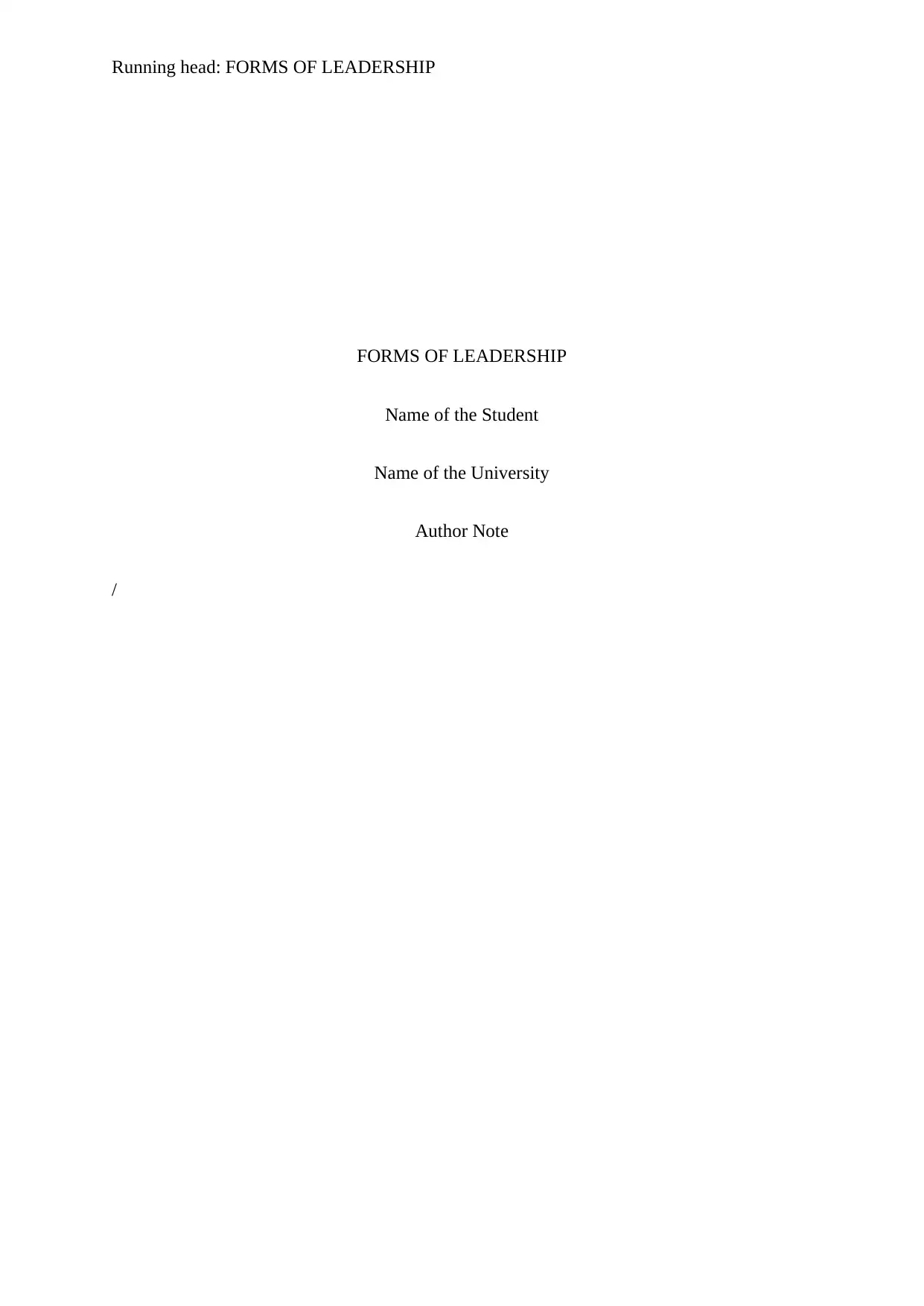
Running head: FORMS OF LEADERSHIP
FORMS OF LEADERSHIP
Name of the Student
Name of the University
Author Note
/
FORMS OF LEADERSHIP
Name of the Student
Name of the University
Author Note
/
Paraphrase This Document
Need a fresh take? Get an instant paraphrase of this document with our AI Paraphraser
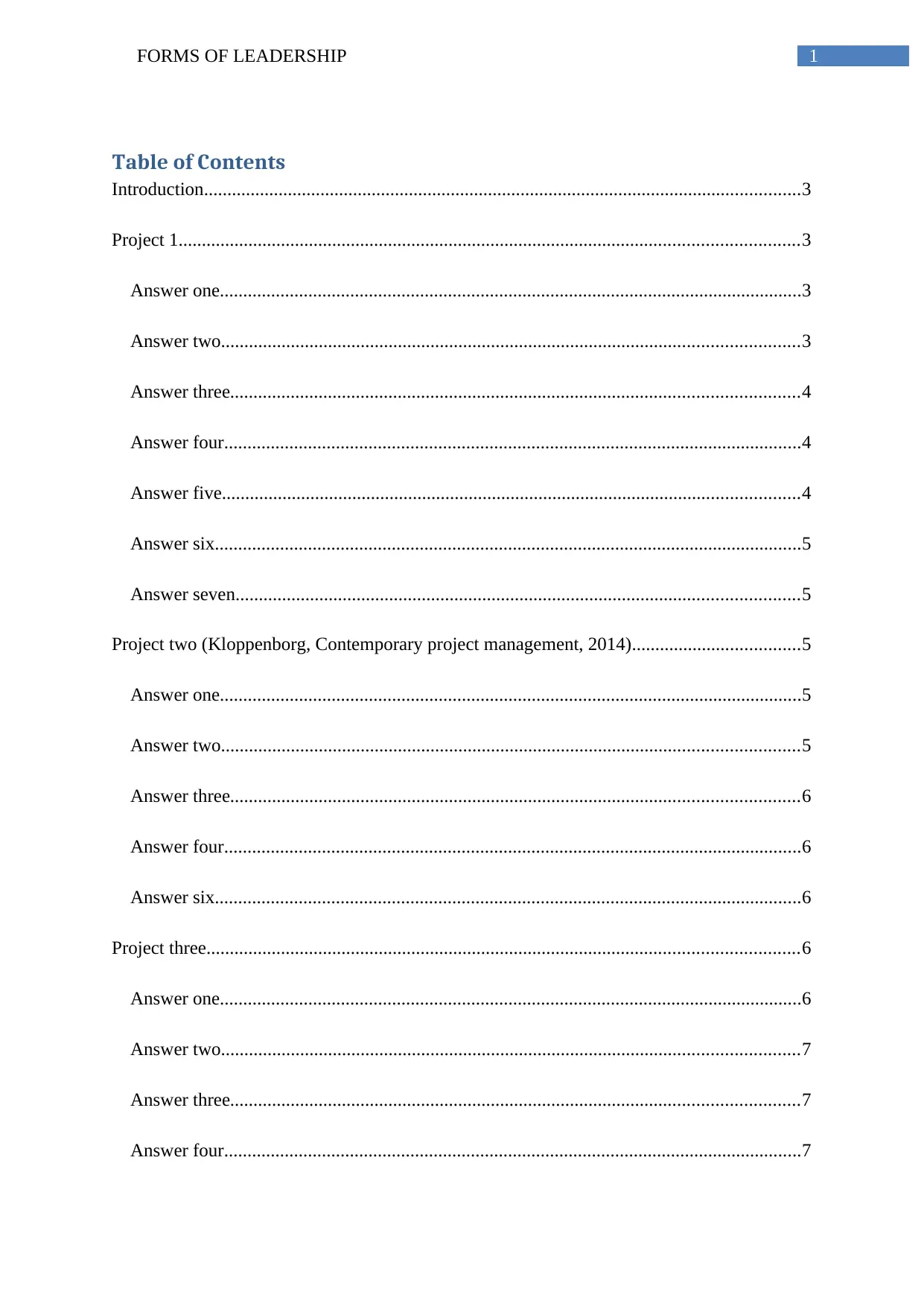
1FORMS OF LEADERSHIP
Table of Contents
Introduction................................................................................................................................3
Project 1.....................................................................................................................................3
Answer one.............................................................................................................................3
Answer two............................................................................................................................3
Answer three..........................................................................................................................4
Answer four............................................................................................................................4
Answer five............................................................................................................................4
Answer six..............................................................................................................................5
Answer seven.........................................................................................................................5
Project two (Kloppenborg, Contemporary project management, 2014)....................................5
Answer one.............................................................................................................................5
Answer two............................................................................................................................5
Answer three..........................................................................................................................6
Answer four............................................................................................................................6
Answer six..............................................................................................................................6
Project three...............................................................................................................................6
Answer one.............................................................................................................................6
Answer two............................................................................................................................7
Answer three..........................................................................................................................7
Answer four............................................................................................................................7
Table of Contents
Introduction................................................................................................................................3
Project 1.....................................................................................................................................3
Answer one.............................................................................................................................3
Answer two............................................................................................................................3
Answer three..........................................................................................................................4
Answer four............................................................................................................................4
Answer five............................................................................................................................4
Answer six..............................................................................................................................5
Answer seven.........................................................................................................................5
Project two (Kloppenborg, Contemporary project management, 2014)....................................5
Answer one.............................................................................................................................5
Answer two............................................................................................................................5
Answer three..........................................................................................................................6
Answer four............................................................................................................................6
Answer six..............................................................................................................................6
Project three...............................................................................................................................6
Answer one.............................................................................................................................6
Answer two............................................................................................................................7
Answer three..........................................................................................................................7
Answer four............................................................................................................................7
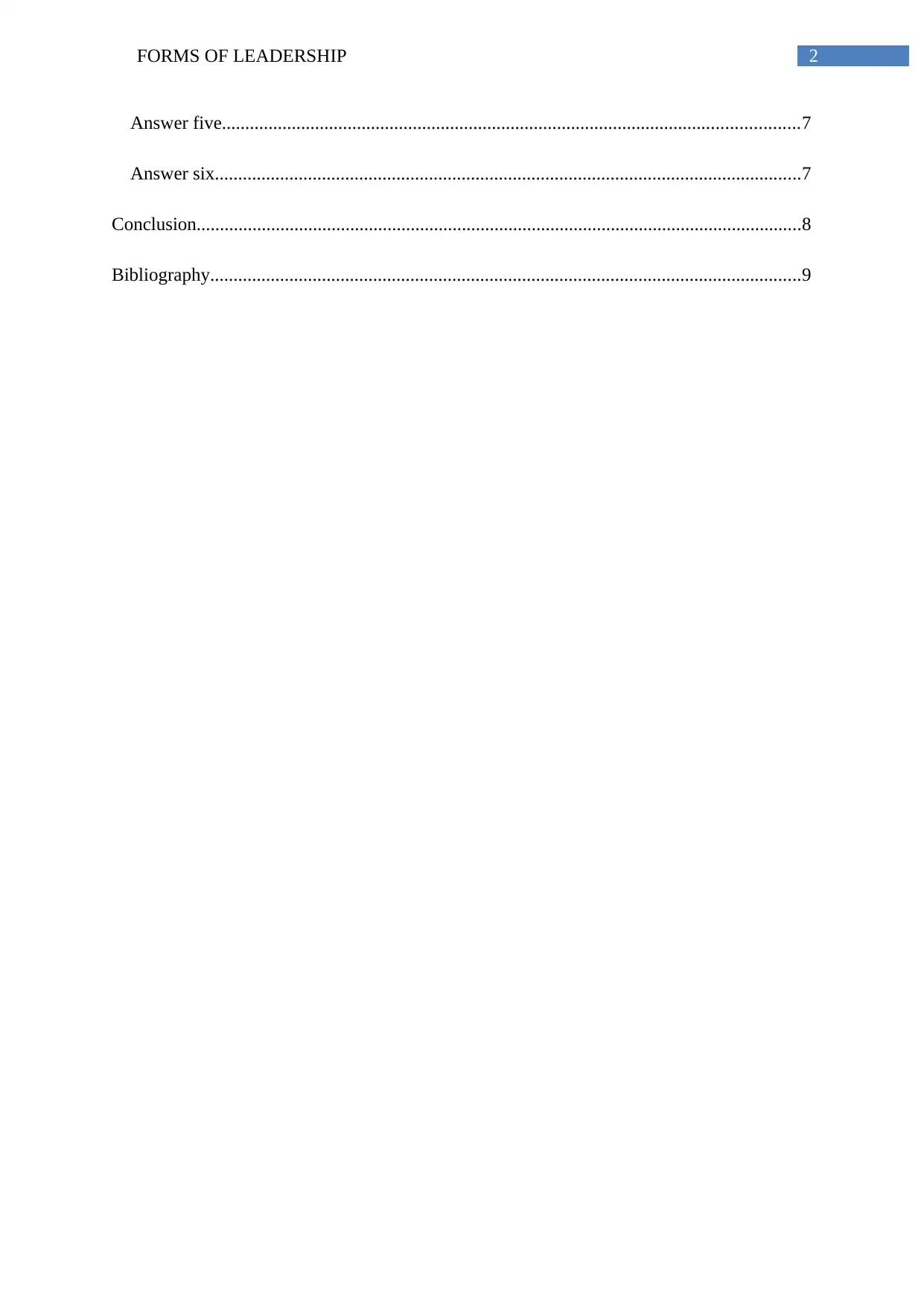
2FORMS OF LEADERSHIP
Answer five............................................................................................................................7
Answer six..............................................................................................................................7
Conclusion..................................................................................................................................8
Bibliography...............................................................................................................................9
Answer five............................................................................................................................7
Answer six..............................................................................................................................7
Conclusion..................................................................................................................................8
Bibliography...............................................................................................................................9
⊘ This is a preview!⊘
Do you want full access?
Subscribe today to unlock all pages.

Trusted by 1+ million students worldwide
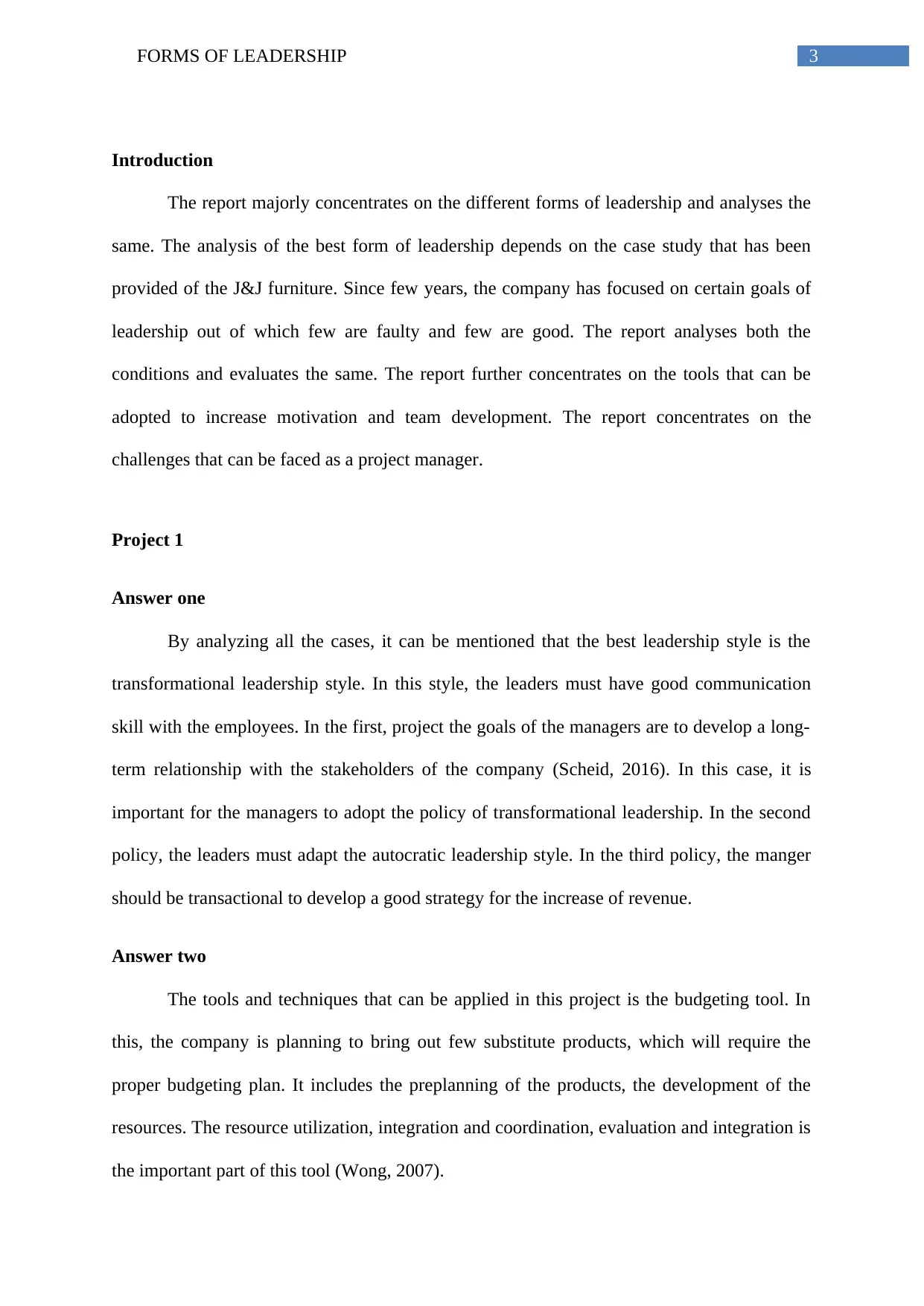
3FORMS OF LEADERSHIP
Introduction
The report majorly concentrates on the different forms of leadership and analyses the
same. The analysis of the best form of leadership depends on the case study that has been
provided of the J&J furniture. Since few years, the company has focused on certain goals of
leadership out of which few are faulty and few are good. The report analyses both the
conditions and evaluates the same. The report further concentrates on the tools that can be
adopted to increase motivation and team development. The report concentrates on the
challenges that can be faced as a project manager.
Project 1
Answer one
By analyzing all the cases, it can be mentioned that the best leadership style is the
transformational leadership style. In this style, the leaders must have good communication
skill with the employees. In the first, project the goals of the managers are to develop a long-
term relationship with the stakeholders of the company (Scheid, 2016). In this case, it is
important for the managers to adopt the policy of transformational leadership. In the second
policy, the leaders must adapt the autocratic leadership style. In the third policy, the manger
should be transactional to develop a good strategy for the increase of revenue.
Answer two
The tools and techniques that can be applied in this project is the budgeting tool. In
this, the company is planning to bring out few substitute products, which will require the
proper budgeting plan. It includes the preplanning of the products, the development of the
resources. The resource utilization, integration and coordination, evaluation and integration is
the important part of this tool (Wong, 2007).
Introduction
The report majorly concentrates on the different forms of leadership and analyses the
same. The analysis of the best form of leadership depends on the case study that has been
provided of the J&J furniture. Since few years, the company has focused on certain goals of
leadership out of which few are faulty and few are good. The report analyses both the
conditions and evaluates the same. The report further concentrates on the tools that can be
adopted to increase motivation and team development. The report concentrates on the
challenges that can be faced as a project manager.
Project 1
Answer one
By analyzing all the cases, it can be mentioned that the best leadership style is the
transformational leadership style. In this style, the leaders must have good communication
skill with the employees. In the first, project the goals of the managers are to develop a long-
term relationship with the stakeholders of the company (Scheid, 2016). In this case, it is
important for the managers to adopt the policy of transformational leadership. In the second
policy, the leaders must adapt the autocratic leadership style. In the third policy, the manger
should be transactional to develop a good strategy for the increase of revenue.
Answer two
The tools and techniques that can be applied in this project is the budgeting tool. In
this, the company is planning to bring out few substitute products, which will require the
proper budgeting plan. It includes the preplanning of the products, the development of the
resources. The resource utilization, integration and coordination, evaluation and integration is
the important part of this tool (Wong, 2007).
Paraphrase This Document
Need a fresh take? Get an instant paraphrase of this document with our AI Paraphraser
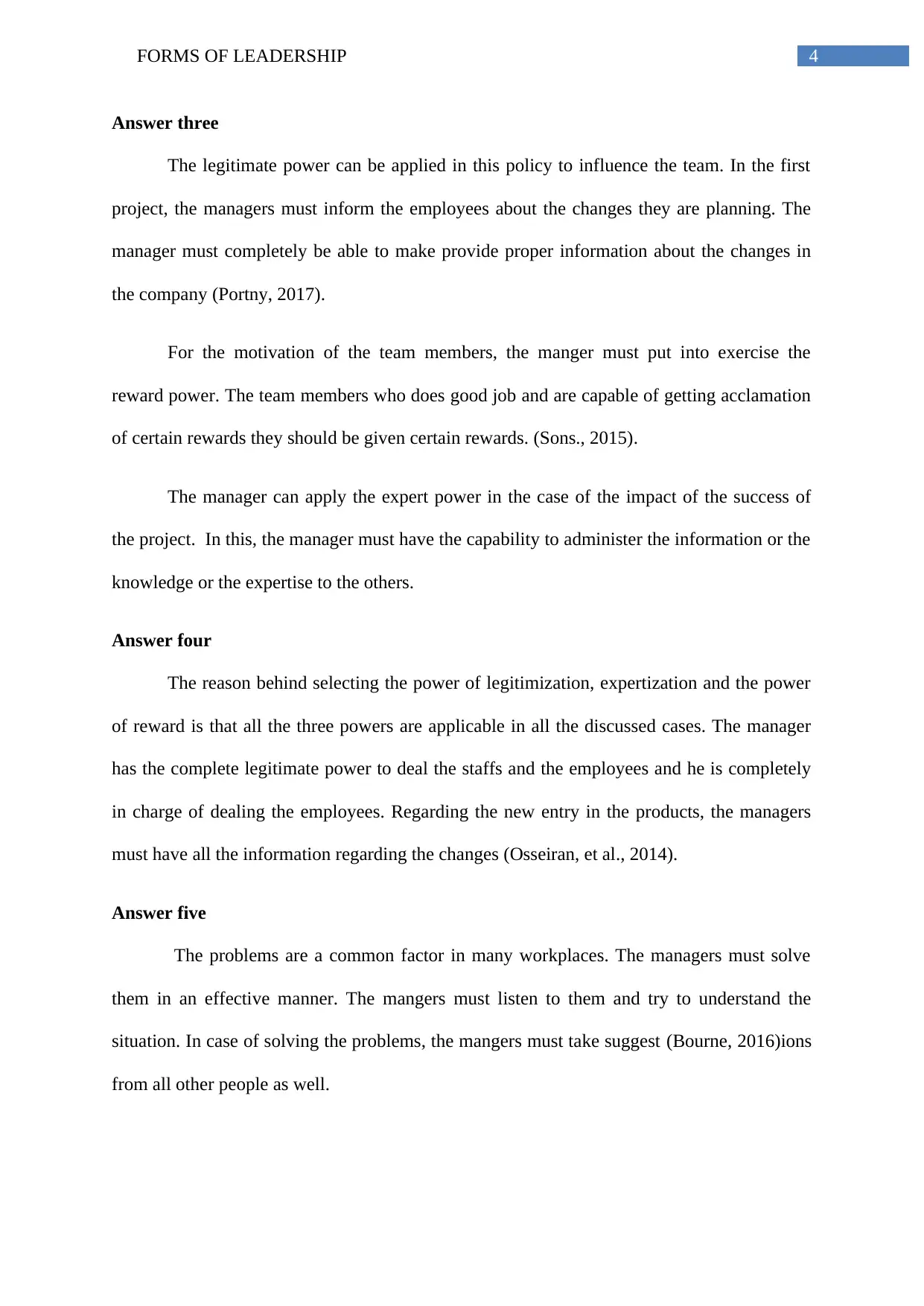
4FORMS OF LEADERSHIP
Answer three
The legitimate power can be applied in this policy to influence the team. In the first
project, the managers must inform the employees about the changes they are planning. The
manager must completely be able to make provide proper information about the changes in
the company (Portny, 2017).
For the motivation of the team members, the manger must put into exercise the
reward power. The team members who does good job and are capable of getting acclamation
of certain rewards they should be given certain rewards. (Sons., 2015).
The manager can apply the expert power in the case of the impact of the success of
the project. In this, the manager must have the capability to administer the information or the
knowledge or the expertise to the others.
Answer four
The reason behind selecting the power of legitimization, expertization and the power
of reward is that all the three powers are applicable in all the discussed cases. The manager
has the complete legitimate power to deal the staffs and the employees and he is completely
in charge of dealing the employees. Regarding the new entry in the products, the managers
must have all the information regarding the changes (Osseiran, et al., 2014).
Answer five
The problems are a common factor in many workplaces. The managers must solve
them in an effective manner. The mangers must listen to them and try to understand the
situation. In case of solving the problems, the mangers must take suggest (Bourne, 2016)ions
from all other people as well.
Answer three
The legitimate power can be applied in this policy to influence the team. In the first
project, the managers must inform the employees about the changes they are planning. The
manager must completely be able to make provide proper information about the changes in
the company (Portny, 2017).
For the motivation of the team members, the manger must put into exercise the
reward power. The team members who does good job and are capable of getting acclamation
of certain rewards they should be given certain rewards. (Sons., 2015).
The manager can apply the expert power in the case of the impact of the success of
the project. In this, the manager must have the capability to administer the information or the
knowledge or the expertise to the others.
Answer four
The reason behind selecting the power of legitimization, expertization and the power
of reward is that all the three powers are applicable in all the discussed cases. The manager
has the complete legitimate power to deal the staffs and the employees and he is completely
in charge of dealing the employees. Regarding the new entry in the products, the managers
must have all the information regarding the changes (Osseiran, et al., 2014).
Answer five
The problems are a common factor in many workplaces. The managers must solve
them in an effective manner. The mangers must listen to them and try to understand the
situation. In case of solving the problems, the mangers must take suggest (Bourne, 2016)ions
from all other people as well.
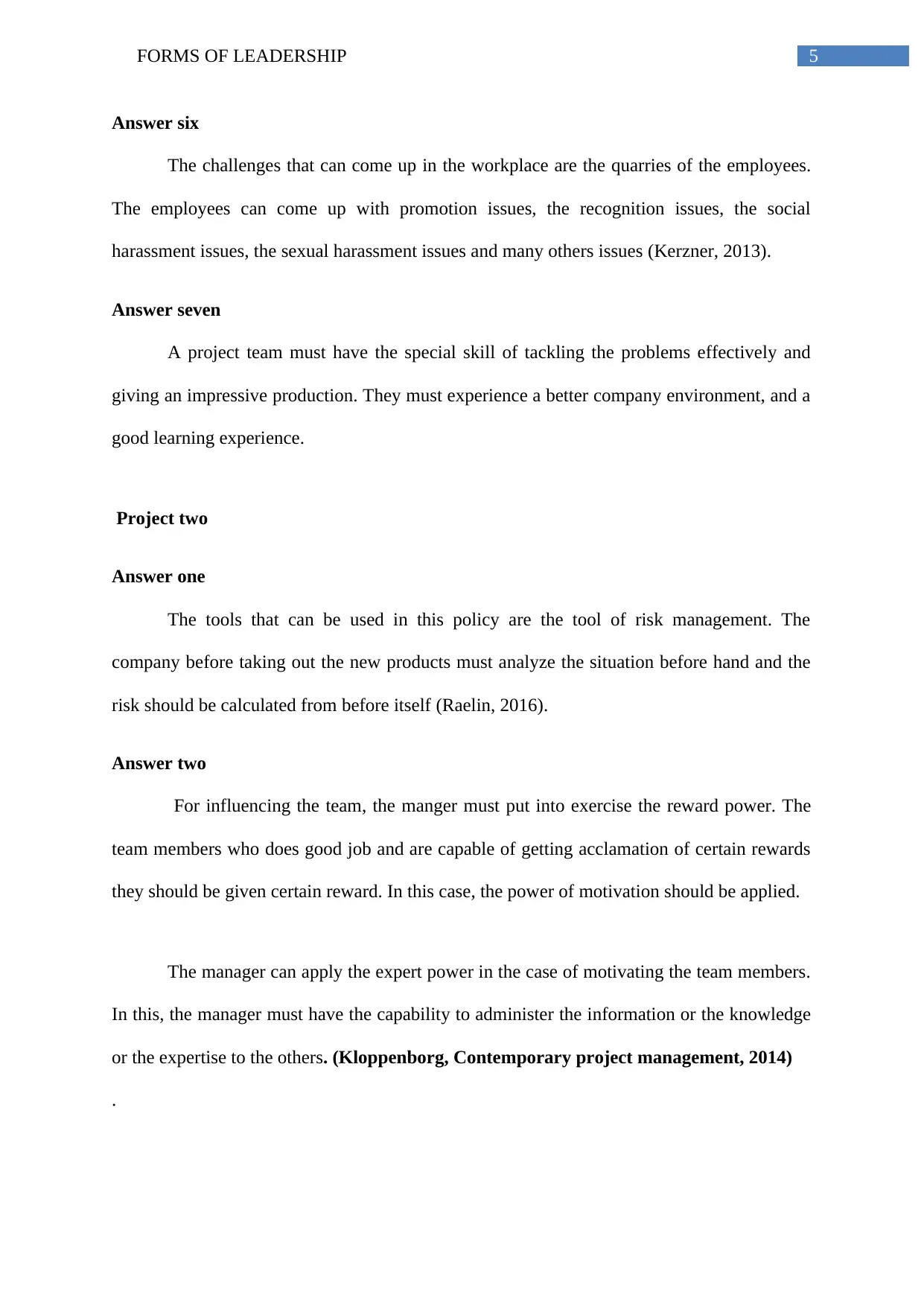
5FORMS OF LEADERSHIP
Answer six
The challenges that can come up in the workplace are the quarries of the employees.
The employees can come up with promotion issues, the recognition issues, the social
harassment issues, the sexual harassment issues and many others issues (Kerzner, 2013).
Answer seven
A project team must have the special skill of tackling the problems effectively and
giving an impressive production. They must experience a better company environment, and a
good learning experience.
Project two
Answer one
The tools that can be used in this policy are the tool of risk management. The
company before taking out the new products must analyze the situation before hand and the
risk should be calculated from before itself (Raelin, 2016).
Answer two
For influencing the team, the manger must put into exercise the reward power. The
team members who does good job and are capable of getting acclamation of certain rewards
they should be given certain reward. In this case, the power of motivation should be applied.
The manager can apply the expert power in the case of motivating the team members.
In this, the manager must have the capability to administer the information or the knowledge
or the expertise to the others. (Kloppenborg, Contemporary project management, 2014)
.
Answer six
The challenges that can come up in the workplace are the quarries of the employees.
The employees can come up with promotion issues, the recognition issues, the social
harassment issues, the sexual harassment issues and many others issues (Kerzner, 2013).
Answer seven
A project team must have the special skill of tackling the problems effectively and
giving an impressive production. They must experience a better company environment, and a
good learning experience.
Project two
Answer one
The tools that can be used in this policy are the tool of risk management. The
company before taking out the new products must analyze the situation before hand and the
risk should be calculated from before itself (Raelin, 2016).
Answer two
For influencing the team, the manger must put into exercise the reward power. The
team members who does good job and are capable of getting acclamation of certain rewards
they should be given certain reward. In this case, the power of motivation should be applied.
The manager can apply the expert power in the case of motivating the team members.
In this, the manager must have the capability to administer the information or the knowledge
or the expertise to the others. (Kloppenborg, Contemporary project management, 2014)
.
⊘ This is a preview!⊘
Do you want full access?
Subscribe today to unlock all pages.

Trusted by 1+ million students worldwide
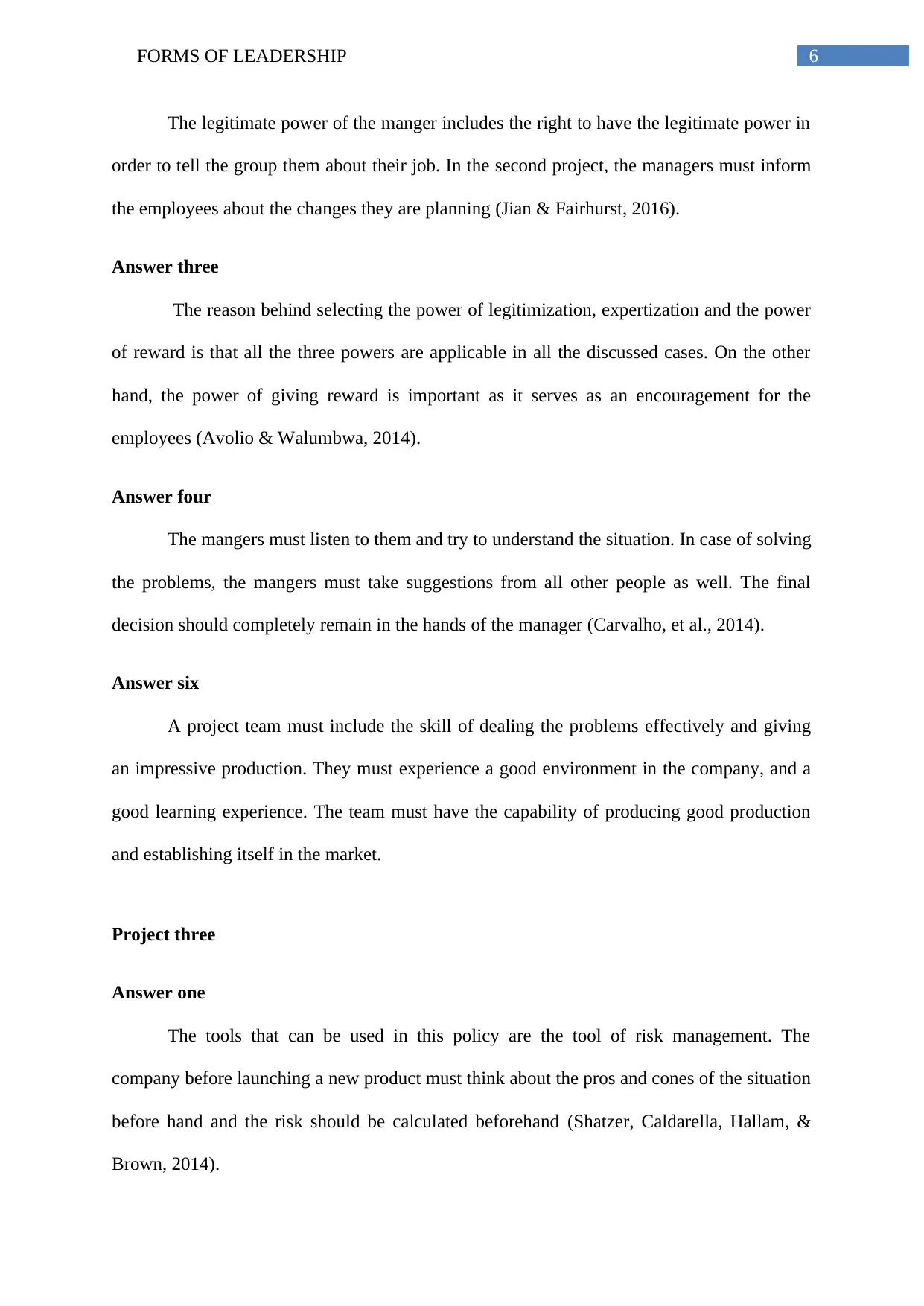
6FORMS OF LEADERSHIP
The legitimate power of the manger includes the right to have the legitimate power in
order to tell the group them about their job. In the second project, the managers must inform
the employees about the changes they are planning (Jian & Fairhurst, 2016).
Answer three
The reason behind selecting the power of legitimization, expertization and the power
of reward is that all the three powers are applicable in all the discussed cases. On the other
hand, the power of giving reward is important as it serves as an encouragement for the
employees (Avolio & Walumbwa, 2014).
Answer four
The mangers must listen to them and try to understand the situation. In case of solving
the problems, the mangers must take suggestions from all other people as well. The final
decision should completely remain in the hands of the manager (Carvalho, et al., 2014).
Answer six
A project team must include the skill of dealing the problems effectively and giving
an impressive production. They must experience a good environment in the company, and a
good learning experience. The team must have the capability of producing good production
and establishing itself in the market.
Project three
Answer one
The tools that can be used in this policy are the tool of risk management. The
company before launching a new product must think about the pros and cones of the situation
before hand and the risk should be calculated beforehand (Shatzer, Caldarella, Hallam, &
Brown, 2014).
The legitimate power of the manger includes the right to have the legitimate power in
order to tell the group them about their job. In the second project, the managers must inform
the employees about the changes they are planning (Jian & Fairhurst, 2016).
Answer three
The reason behind selecting the power of legitimization, expertization and the power
of reward is that all the three powers are applicable in all the discussed cases. On the other
hand, the power of giving reward is important as it serves as an encouragement for the
employees (Avolio & Walumbwa, 2014).
Answer four
The mangers must listen to them and try to understand the situation. In case of solving
the problems, the mangers must take suggestions from all other people as well. The final
decision should completely remain in the hands of the manager (Carvalho, et al., 2014).
Answer six
A project team must include the skill of dealing the problems effectively and giving
an impressive production. They must experience a good environment in the company, and a
good learning experience. The team must have the capability of producing good production
and establishing itself in the market.
Project three
Answer one
The tools that can be used in this policy are the tool of risk management. The
company before launching a new product must think about the pros and cones of the situation
before hand and the risk should be calculated beforehand (Shatzer, Caldarella, Hallam, &
Brown, 2014).
Paraphrase This Document
Need a fresh take? Get an instant paraphrase of this document with our AI Paraphraser
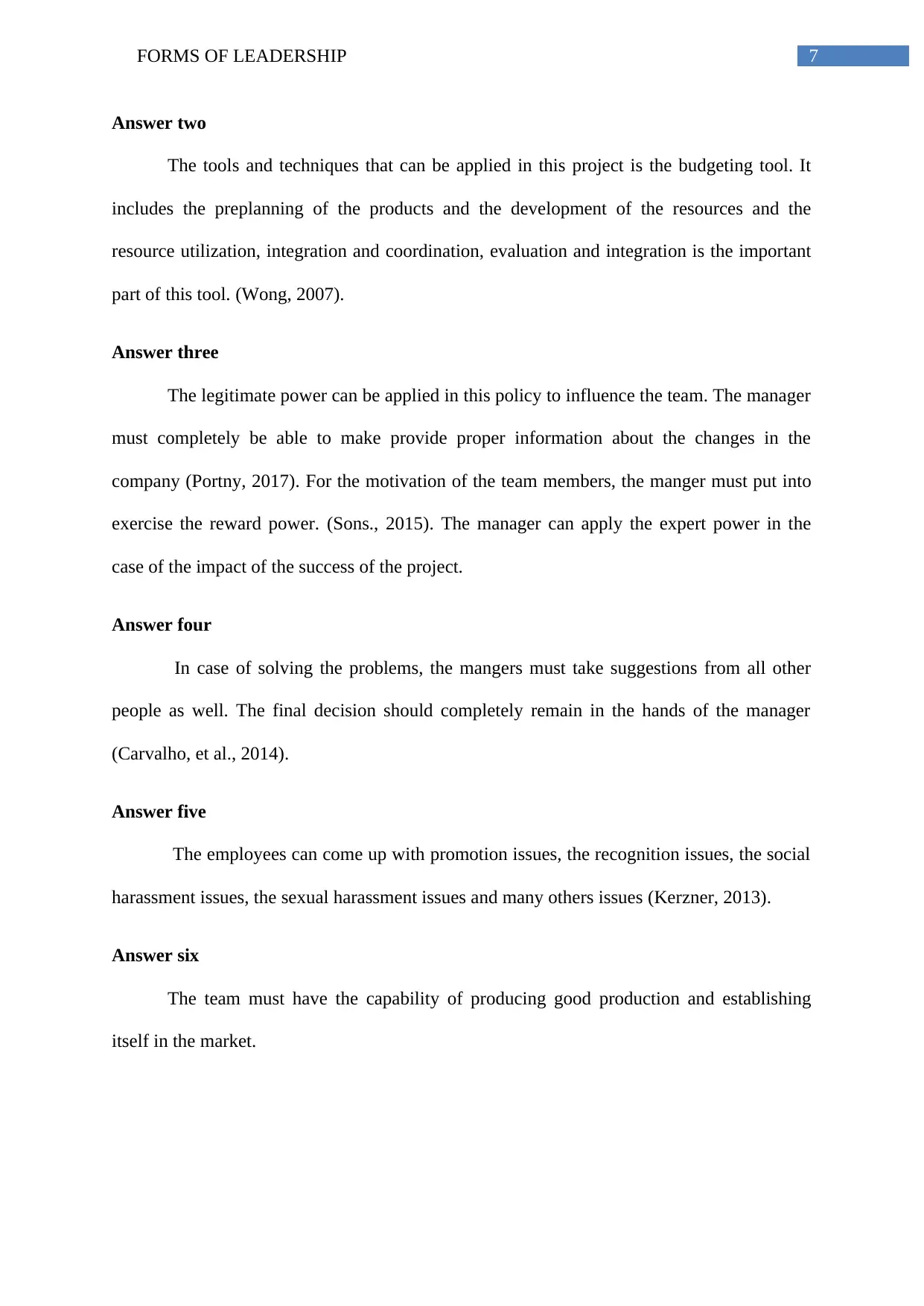
7FORMS OF LEADERSHIP
Answer two
The tools and techniques that can be applied in this project is the budgeting tool. It
includes the preplanning of the products and the development of the resources and the
resource utilization, integration and coordination, evaluation and integration is the important
part of this tool. (Wong, 2007).
Answer three
The legitimate power can be applied in this policy to influence the team. The manager
must completely be able to make provide proper information about the changes in the
company (Portny, 2017). For the motivation of the team members, the manger must put into
exercise the reward power. (Sons., 2015). The manager can apply the expert power in the
case of the impact of the success of the project.
Answer four
In case of solving the problems, the mangers must take suggestions from all other
people as well. The final decision should completely remain in the hands of the manager
(Carvalho, et al., 2014).
Answer five
The employees can come up with promotion issues, the recognition issues, the social
harassment issues, the sexual harassment issues and many others issues (Kerzner, 2013).
Answer six
The team must have the capability of producing good production and establishing
itself in the market.
Answer two
The tools and techniques that can be applied in this project is the budgeting tool. It
includes the preplanning of the products and the development of the resources and the
resource utilization, integration and coordination, evaluation and integration is the important
part of this tool. (Wong, 2007).
Answer three
The legitimate power can be applied in this policy to influence the team. The manager
must completely be able to make provide proper information about the changes in the
company (Portny, 2017). For the motivation of the team members, the manger must put into
exercise the reward power. (Sons., 2015). The manager can apply the expert power in the
case of the impact of the success of the project.
Answer four
In case of solving the problems, the mangers must take suggestions from all other
people as well. The final decision should completely remain in the hands of the manager
(Carvalho, et al., 2014).
Answer five
The employees can come up with promotion issues, the recognition issues, the social
harassment issues, the sexual harassment issues and many others issues (Kerzner, 2013).
Answer six
The team must have the capability of producing good production and establishing
itself in the market.
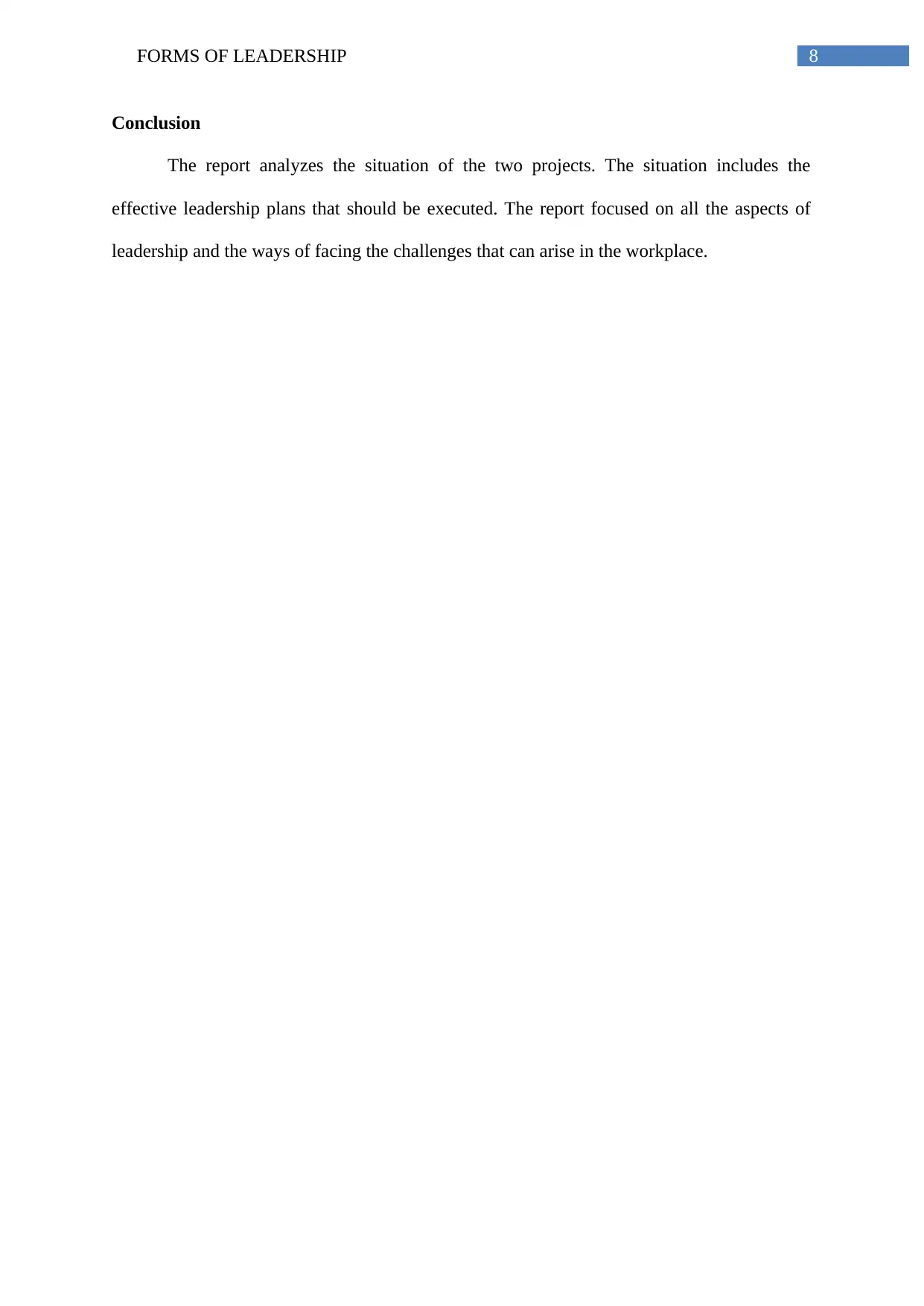
8FORMS OF LEADERSHIP
Conclusion
The report analyzes the situation of the two projects. The situation includes the
effective leadership plans that should be executed. The report focused on all the aspects of
leadership and the ways of facing the challenges that can arise in the workplace.
Conclusion
The report analyzes the situation of the two projects. The situation includes the
effective leadership plans that should be executed. The report focused on all the aspects of
leadership and the ways of facing the challenges that can arise in the workplace.
⊘ This is a preview!⊘
Do you want full access?
Subscribe today to unlock all pages.

Trusted by 1+ million students worldwide
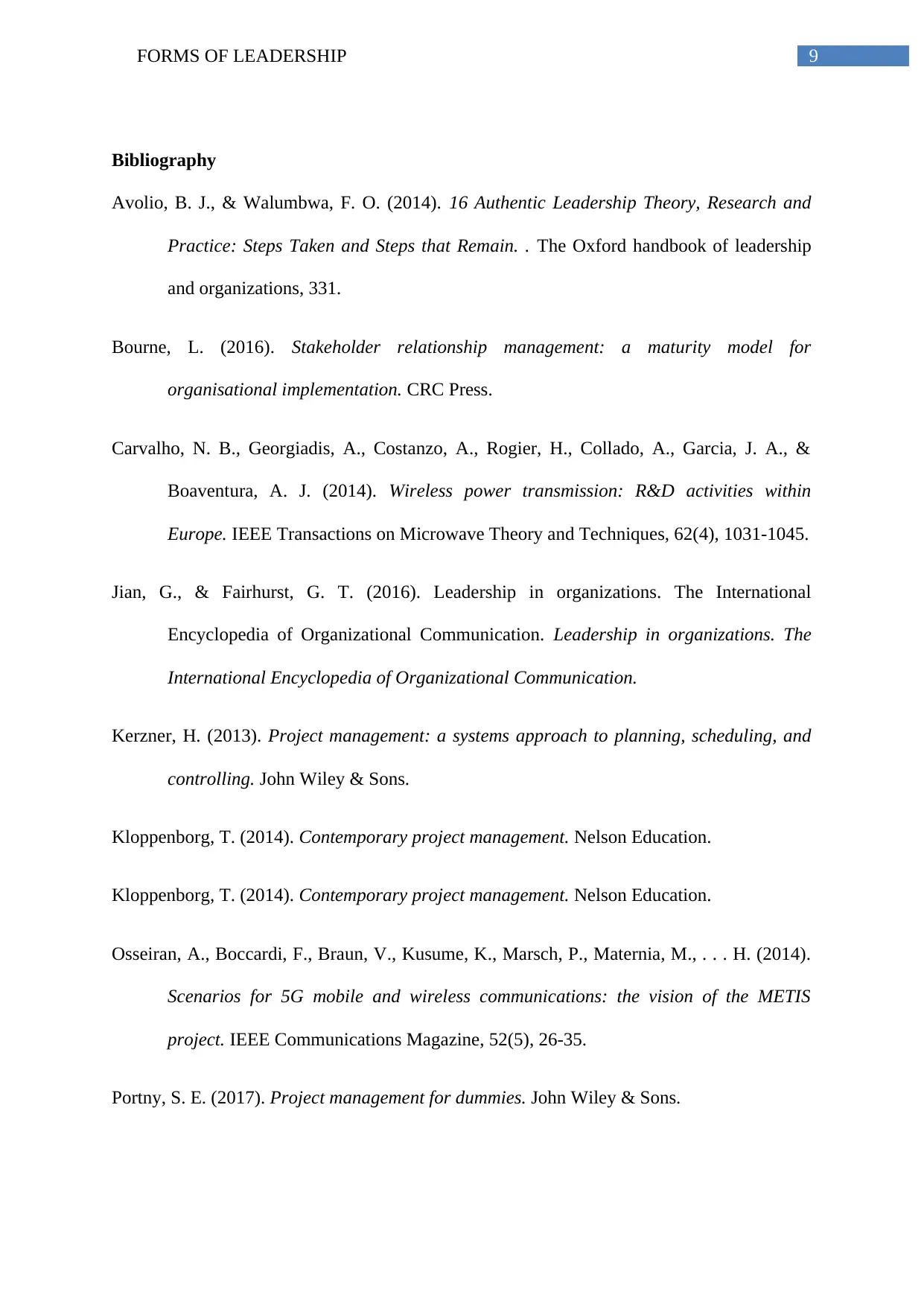
9FORMS OF LEADERSHIP
Bibliography
Avolio, B. J., & Walumbwa, F. O. (2014). 16 Authentic Leadership Theory, Research and
Practice: Steps Taken and Steps that Remain. . The Oxford handbook of leadership
and organizations, 331.
Bourne, L. (2016). Stakeholder relationship management: a maturity model for
organisational implementation. CRC Press.
Carvalho, N. B., Georgiadis, A., Costanzo, A., Rogier, H., Collado, A., Garcia, J. A., &
Boaventura, A. J. (2014). Wireless power transmission: R&D activities within
Europe. IEEE Transactions on Microwave Theory and Techniques, 62(4), 1031-1045.
Jian, G., & Fairhurst, G. T. (2016). Leadership in organizations. The International
Encyclopedia of Organizational Communication. Leadership in organizations. The
International Encyclopedia of Organizational Communication.
Kerzner, H. (2013). Project management: a systems approach to planning, scheduling, and
controlling. John Wiley & Sons.
Kloppenborg, T. (2014). Contemporary project management. Nelson Education.
Kloppenborg, T. (2014). Contemporary project management. Nelson Education.
Osseiran, A., Boccardi, F., Braun, V., Kusume, K., Marsch, P., Maternia, M., . . . H. (2014).
Scenarios for 5G mobile and wireless communications: the vision of the METIS
project. IEEE Communications Magazine, 52(5), 26-35.
Portny, S. E. (2017). Project management for dummies. John Wiley & Sons.
Bibliography
Avolio, B. J., & Walumbwa, F. O. (2014). 16 Authentic Leadership Theory, Research and
Practice: Steps Taken and Steps that Remain. . The Oxford handbook of leadership
and organizations, 331.
Bourne, L. (2016). Stakeholder relationship management: a maturity model for
organisational implementation. CRC Press.
Carvalho, N. B., Georgiadis, A., Costanzo, A., Rogier, H., Collado, A., Garcia, J. A., &
Boaventura, A. J. (2014). Wireless power transmission: R&D activities within
Europe. IEEE Transactions on Microwave Theory and Techniques, 62(4), 1031-1045.
Jian, G., & Fairhurst, G. T. (2016). Leadership in organizations. The International
Encyclopedia of Organizational Communication. Leadership in organizations. The
International Encyclopedia of Organizational Communication.
Kerzner, H. (2013). Project management: a systems approach to planning, scheduling, and
controlling. John Wiley & Sons.
Kloppenborg, T. (2014). Contemporary project management. Nelson Education.
Kloppenborg, T. (2014). Contemporary project management. Nelson Education.
Osseiran, A., Boccardi, F., Braun, V., Kusume, K., Marsch, P., Maternia, M., . . . H. (2014).
Scenarios for 5G mobile and wireless communications: the vision of the METIS
project. IEEE Communications Magazine, 52(5), 26-35.
Portny, S. E. (2017). Project management for dummies. John Wiley & Sons.
Paraphrase This Document
Need a fresh take? Get an instant paraphrase of this document with our AI Paraphraser
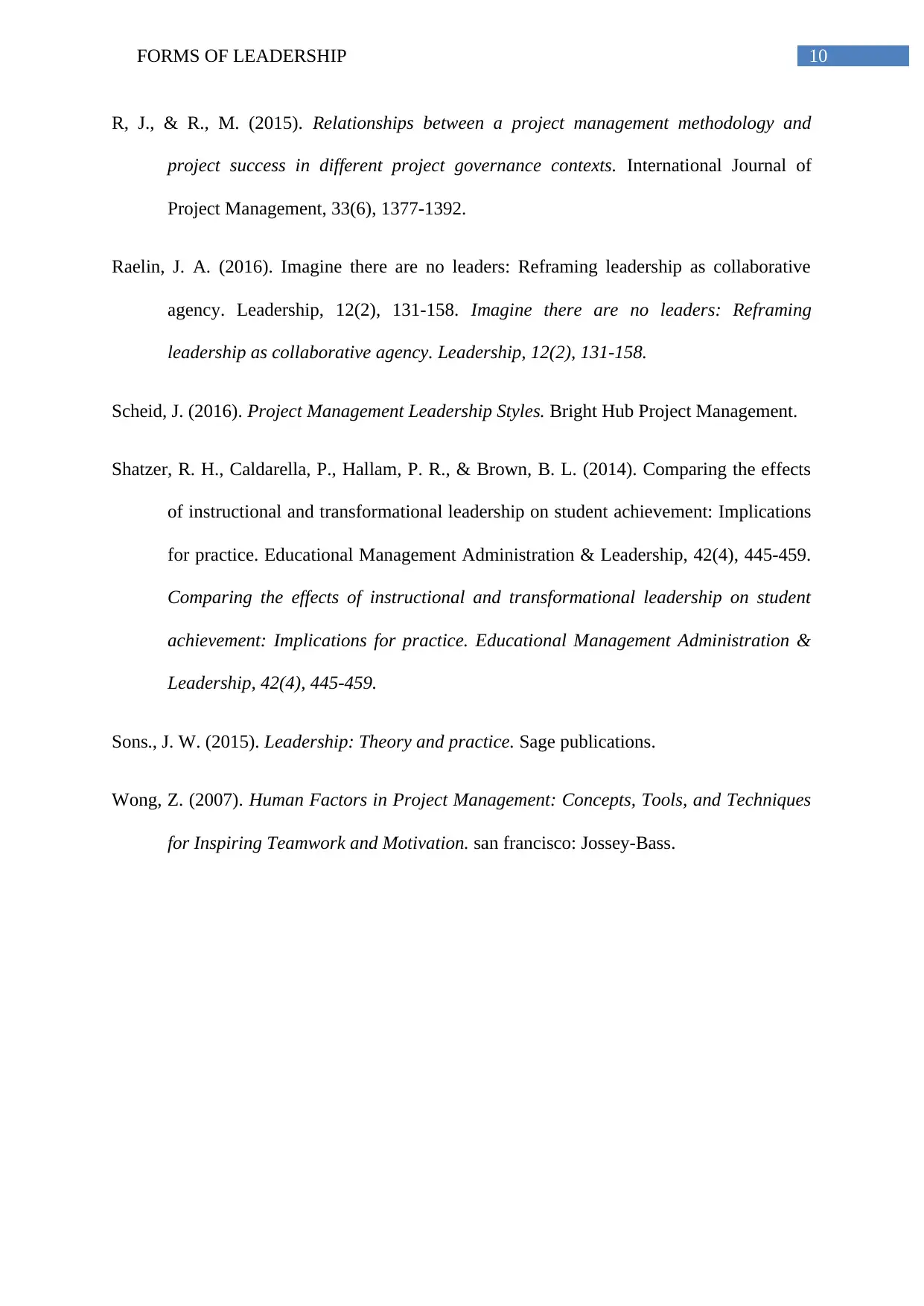
10FORMS OF LEADERSHIP
R, J., & R., M. (2015). Relationships between a project management methodology and
project success in different project governance contexts. International Journal of
Project Management, 33(6), 1377-1392.
Raelin, J. A. (2016). Imagine there are no leaders: Reframing leadership as collaborative
agency. Leadership, 12(2), 131-158. Imagine there are no leaders: Reframing
leadership as collaborative agency. Leadership, 12(2), 131-158.
Scheid, J. (2016). Project Management Leadership Styles. Bright Hub Project Management.
Shatzer, R. H., Caldarella, P., Hallam, P. R., & Brown, B. L. (2014). Comparing the effects
of instructional and transformational leadership on student achievement: Implications
for practice. Educational Management Administration & Leadership, 42(4), 445-459.
Comparing the effects of instructional and transformational leadership on student
achievement: Implications for practice. Educational Management Administration &
Leadership, 42(4), 445-459.
Sons., J. W. (2015). Leadership: Theory and practice. Sage publications.
Wong, Z. (2007). Human Factors in Project Management: Concepts, Tools, and Techniques
for Inspiring Teamwork and Motivation. san francisco: Jossey-Bass.
R, J., & R., M. (2015). Relationships between a project management methodology and
project success in different project governance contexts. International Journal of
Project Management, 33(6), 1377-1392.
Raelin, J. A. (2016). Imagine there are no leaders: Reframing leadership as collaborative
agency. Leadership, 12(2), 131-158. Imagine there are no leaders: Reframing
leadership as collaborative agency. Leadership, 12(2), 131-158.
Scheid, J. (2016). Project Management Leadership Styles. Bright Hub Project Management.
Shatzer, R. H., Caldarella, P., Hallam, P. R., & Brown, B. L. (2014). Comparing the effects
of instructional and transformational leadership on student achievement: Implications
for practice. Educational Management Administration & Leadership, 42(4), 445-459.
Comparing the effects of instructional and transformational leadership on student
achievement: Implications for practice. Educational Management Administration &
Leadership, 42(4), 445-459.
Sons., J. W. (2015). Leadership: Theory and practice. Sage publications.
Wong, Z. (2007). Human Factors in Project Management: Concepts, Tools, and Techniques
for Inspiring Teamwork and Motivation. san francisco: Jossey-Bass.
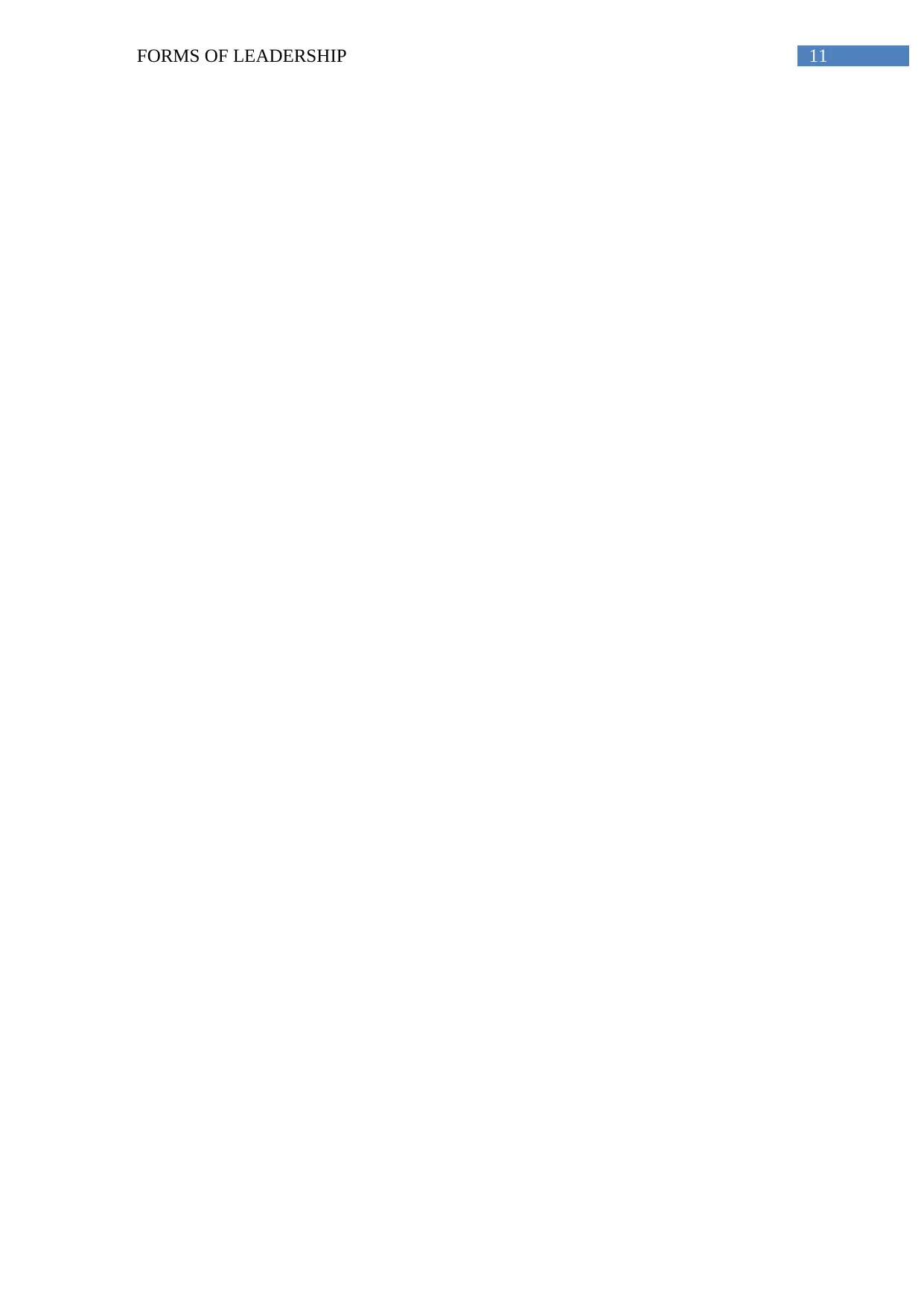
11FORMS OF LEADERSHIP
⊘ This is a preview!⊘
Do you want full access?
Subscribe today to unlock all pages.

Trusted by 1+ million students worldwide
1 out of 12
Related Documents
Your All-in-One AI-Powered Toolkit for Academic Success.
+13062052269
info@desklib.com
Available 24*7 on WhatsApp / Email
![[object Object]](/_next/static/media/star-bottom.7253800d.svg)
Unlock your academic potential
Copyright © 2020–2025 A2Z Services. All Rights Reserved. Developed and managed by ZUCOL.





